Health and Care Experience Survey: results 2019/2020
Results from the 2019/2020 Health and Care Experience Survey
4. The GP Practice
Contacting the GP Practice
The survey asked respondents when they had last contacted the GP practice named on the survey letter. Eighty six per cent had contacted the named GP practice in the last twelve months. Those who had not attended the GP practice named in the last twelve months or attend a different GP practice were asked to skip questions on the GP practice and move on to the next section.
For those who had contacted their GP practice in the last twelve months, roughly a third of people (thirty two per cent) had contacted it five or more times, around half had contacted it between two and four times and around seventeen per cent had contacted it once. This a very similar pattern to that seen in the 2017/18 survey.
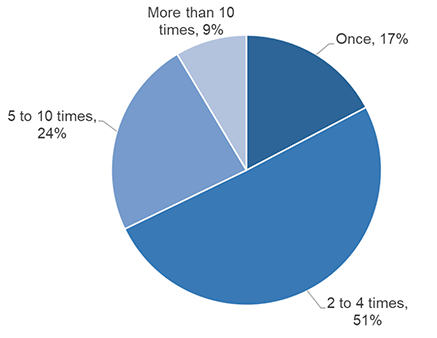
The majority of people (eighty five per cent) found it easy to contact their GP practice in the way that they want, with almost half of people finding it very easy.
Respondents were asked what they thought of the opening hours of their GP practice:
- Seventy seven per cent of people were happy with them;
- Seventeen per cent of people were not happy with the opening hours – for most of these people this was because it was too difficult to get time away from work during the practice's opening hours; and
- Six per cent of people were not sure what the opening hours of their GP practice were.
This is consistent with responses to this question in previous surveys.
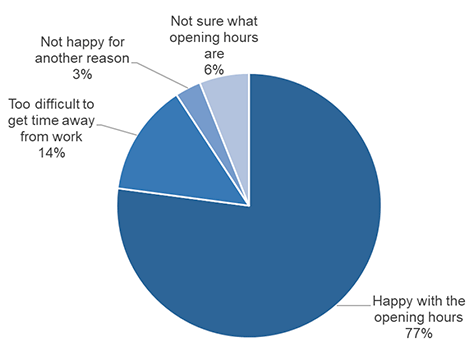
Receptionists
Respondents were asked how they would rate the quality of the information provided by the receptionist at their GP practice. Just over three quarters of people (seventy six per cent) rated the quality of information positively ('Excellent' or 'Good'); seventeen per cent rated it as 'Fair' and six per cent rated it negatively ('Poor' or 'Very poor').
Access to Appointments
GP practices are expected to provide reasonable and appropriate access for their patients as part of their services. To monitor this, each NHS board in Scotland is required to meet a Local Delivery Plan (LDP) Standard[9] on the percentage of individuals able to:
- obtain access to a doctor or nurse within two working days; and
- book an appointment in advance.
Respondents were asked how long they had to wait the last time they needed to see or speak to a doctor or a nurse from their GP practice quite urgently. Of those who had needed to see or speak to a doctor / nurse, eighty six per cent were able to do so within two working days. This is slightly lower than in 2017/18 (eighty seven per cent), but higher than earlier years (eighty four per cent in both 2015/16 and 2013/14).
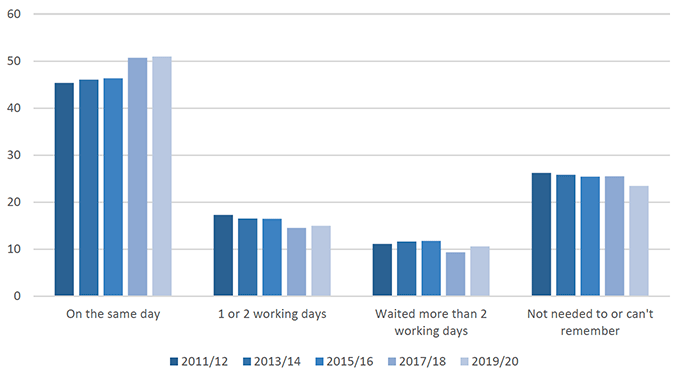
Of those who were unable to see or speak to a doctor / nurse within two working days, around three fifths (sixty one per cent) were not offered a chance to. Just under a quarter of people (twenty three per cent) waited longer than two working days because the person they wanted to see was not available and seven per cent of people waited because the times available were not convenient for them. The remaining nine per cent waited for another reason.
For the LDP Standard, individuals are considered to have been able to obtain two working day access if they were offered an appointment within two working days, even if they then turned the appointment down. Considering the results in this way, ninety two per cent of people who needed to see or speak to a doctor or nurse quite urgently were able to do so or were offered an appointment within two working days. This is above the LDP Standard of ninety per cent and is a slight decrease from the last survey (ninety three per cent).
The survey also asked respondents if their GP practice allowed them to make an appointment with a doctor three or more working days in advance. A quarter of people (twenty six per cent) did not know – this is consistent with previous surveys (twenty five and twenty six per cent in 2017/18 and 2015/16 respectively).
Of those who did know, sixty four per cent of people said that they were allowed to book an appointment three or more working days in advance. This is a decrease from previous surveys where sixty eight per cent of people in 2017/18 were allowed to book an appointment three or more working days in advance (seventy seven per cent in both 2015/16 and 2013/14). This continues to be significantly below the LDP Standard.
Respondents were asked whether the appointment they got was face to face at the GP practice or via phone or video call or a home visit. The majority (eighty seven per cent) of respondents had a face-to-face appointment, with eleven per cent of respondents having a phone appointment. Only around one per cent had a home visit and even fewer reported having a video call or email consultation (less than half a percent combined).
Overall Arrangements to See a Healthcare Professional
Respondents were asked to rate the arrangements for getting to see various healthcare professionals in their GP practice. Around two thirds of people (sixty seven per cent) rated the arrangements to see a doctor positively compared with seventy nine per cent seeing a nurse.
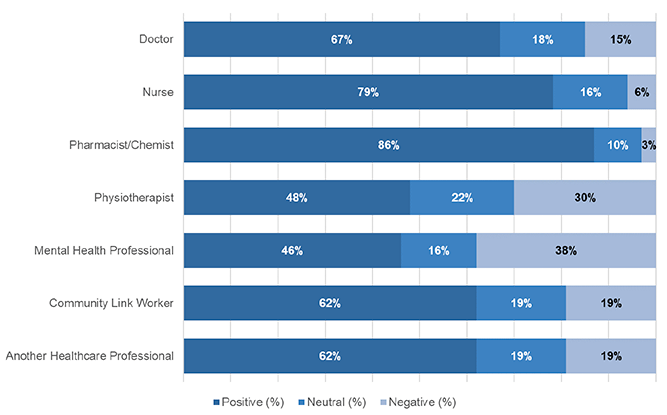
Overall Experience of Care provided by the GP Practice
When asked to rate the care provided by their GP practice overall, seventy nine per cent of people rated it positively. This shows a decrease of four percentage points compared to the previous survey and a decrease of eleven percentage points compared to the first Health & Care Experience Survey in 2009/10, as shown in Figure 5.6.
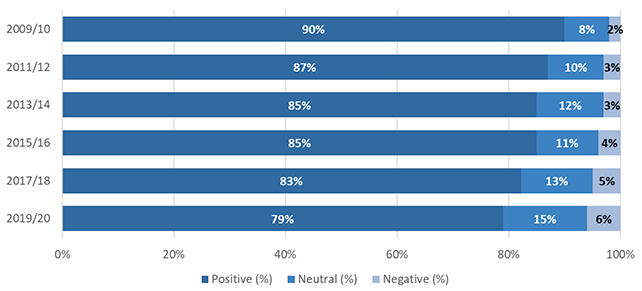
Contact
Email: patientexperience@gov.scot
There is a problem
Thanks for your feedback